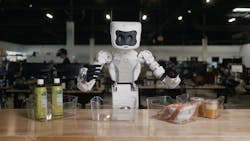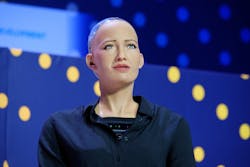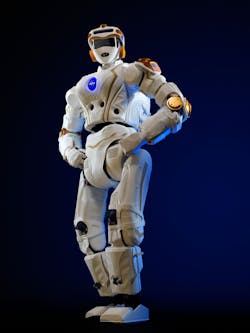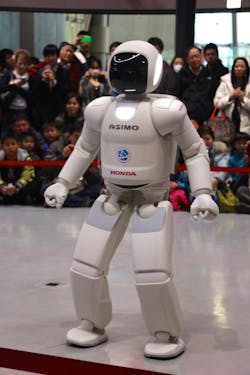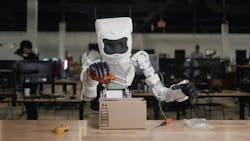Building the Future One Humanoid Robot at a Time
Around five to six years ago—give or take a few—there was a fervor in the industry and commercial markets about robots. Not just any robots—humanoid and mobile helper robots.
There was the little robot Jibo developed at MIT by Cynthia Breazeal, the founder and director of the Personal Robots group at the Media Lab. It was this adorable three-axis bot that looked like a flightless, armless Eve from "WALL-E" and acted as a personal assistant for the home. Then Sophia, the social humanoid robot, was activated in 2016, which in my opinion is much more akin to a nightmare with her eerily-like human qualities—but not far off from what was presented in the movie Ex Machina. If you haven't seen it, I suggest you do so soon.
There were many, many others that have come and gone over the years, but ultimately, the fervor died down, and with it, so did these types of robots in favor of more practical and known robotic technology.
The Gartner Hype Cycle chart details where certain technologies are at in their lifecycle, and what we were likely seeing then is the excitement that the technology existed—the future was here. And that's exactly what it was. Looking back at previous hype cycles, smart robots were just hitting their peak of inflated expectations around 2016 before dropping down into the trough of disillusionment; where we realized that we didn't quite have the technology to support this just yet. We had all the pieces and parts certainly, but when combined together, it was clear that there was still a lot of work that needed to be done to make these robots tried and true.
As the editor of a product-focused publication, I see a lot of what's new and the latest research and development coming out in the industry, and over the past six years, I haven't noticed a lot of humanoid, legged or facial-featured robotics. Most of the robots in the past few years have been your standard industrial robots and cobots, and we've of course seen a huge surge in automated mobile robots. What used to be only for warehouse transport applications has now become automated storage/retrieval systems, machining tooling transport, heavy-duty transport, picking, and more.
We've certainly seen the technology evolve, but there hasn't been much going on in the public eye for humanoid robots. Sure, we've got Spot from Boston Dynamics, but Spot is a dog-like robot and while it's always fun to see Spot in his publicity stunts, it's still not where we thought we would be. I think we all thought we would have flying cars by now—at least I did.
But don't fear. In the past year or so, I've started to see more and more coming out about new robots that can walk on two legs as humans do and take on dangerous tasks, strenuous tasks, undesirable tasks, and so on.
For example, igus, the plastic bearing specialist, recently presented a prototype at Hannover Messe in 2022. Simply referred to as the igus motion plastics bot, it's designed to be a helper for such things as mowing the lawn, grocery shopping or even laundry. And while it doesn't have legs, it does have a fixed base with arms and can move around un-fixed. Agility Robotics recently launched its warehouse robot Digit which is a bipedal robot designed to take on the strenuous activities workers routinely injure themselves with. Sarcos Robotics launched its GuardianXT robot that, while it doesn't operate entirely on its own, can be manipulated remotely to take on jobs that are at height; anything from welding to pick-and-place.
But then I found out about a company named Apptronik, which has been in the game of researching, prototyping, and developing general-purpose, humanoid robots for years. I spoke with Jeff Cardenas, co-founder and CEO of Apptronik, to get insight into this next generation of robots that will change how we live and work and where he sees robotics going in the long run.
The Beginnings
Jeff Cardenas always knew that he wanted to be an entrepreneur, especially in the area of high technology with hopes of building the future. "I had seen computers and then the internet. Then when I was in school, mobile was the big thing. So my lens was like, what's the next big thing," says Cardenas.
He ended up graduating with a degree in technology commercialization and became interested in the way the U.S. government was continually funding billions of dollars into research and development of core technologies that we see come to market, or more commonly, don't end up going anywhere.
This led him to start working in the innovation school at the University of Texas, scouting out what the next big thing in technology might be. This is where he met the other two co-founders of Apptronik: Dr. Luis Sentis and Dr. Nick Paine.
Dr. Sentis was running the Human Centered Robotics Lab at the University of Texas—and still is today—and Dr. Paine, who is now the CTO, was one of Dr. Sentis' first graduate students. Both of them were coming off of the DARPA Robotics Challenge (DRC) in 2012, having worked on the NASA Johnson Space Center Valkyrie team.
Back during the Fukushima Nuclear disaster, the U.S. government started the DRC as a call to get people working on the technology we needed for disaster relief and recovery. Engineers and researchers went to town creating robots to do these extremely dangerous jobs not only so humans wouldn't have to put themselves in harm's way, but also so that we could respond in a timely and effective manner. The primary goal was to develop human-supervised ground robots capable of executing complex tasks in dangerous, degraded, human-engineered environments. Competitors in the DRC developed robots that could use standard tools and equipment commonly available, ranging from hand tools to vehicles.
"From the moment I saw the Valkyrie I thought, that's it. That's the next big thing. And I was kind of taken by this idea that I thought that the more I learned about robotics, that, of course, robots are going to become more versatile just by the fact that they're so limited today. It's just a byproduct of where the technology is at that they're definitely going to become more versatile and ubiquitous," says Cardenas.
In addition to his interest in Valkyrie and what it could do, he realized that even though the industrial robot was invented here in the U.S., 100% of all industrial robots were being produced in foreign countries. "And so I thought, robots are going to become more versatile and there's no one making them, especially here in the U.S. So I thought that it was worth pursuing. And that's our goal: to build one of the greatest robotics companies in the world," explains Cardenas.
After working with his co-founders through grad school, Apptronik became a reality in 2016 as a spin-off from the HCR lab. It's clear that the full-stack robotics company is made up of engineers who truly love what they do, focusing on building general-purpose robots that are versatile and designed to work with and for humans.
The DRC spurred so much interest and projects around these new robots, which led to the frenzy I talked about before around 2016. The DRC had its finals in 2015. However, these robots cost millions of dollars at the time and were limited in what they could do. The biggest challenges they seemed to have were holding and grabbing objects, not to mention falling over, having trouble going up and down stairs, opening doors, etc.
So this is why Apptronik was founded: to set out to commercialize general-purpose robots and solve a lot of the technology challenges that were needed to bring them to market.
Over the past seven years, the company has built all sorts of different robots from humanoids to robotic arms to robotic exoskeletons and even robotic prosthetics. It's not just that they've been creating these robots and perfecting them, but they've spent a lot of time advancing the performance of these robots as well as the way that they're built, focusing on making them more affordable, flexible, lightweight, and easy for mass production and customization.
"In my opinion, it's really delivering on what robotics has always promised; this idea of highly versatile robots that can both be mobile and also manipulate the world around them. The stuff from the movies is now becoming more and more possible."
"A humanoid has 30 plus motors in it compared to just a standard industrial arm. So you have to rethink the way you build it so that it's not four or five times more expensive than an industrial arm. And then you've had advances in edge computing and the underlying algorithms, both in perception and walking. So just a ton of technological advancement has happened since the DARPA Robotics Challenge to really kind of make these viable," explains Cardenas.
He goes on to equate that where we are right now with robotic technology is similar to the early 1980s and the rise of personal computers. They were great for their time, novel and exciting, but just the start of what's to come. And think about that, if someone put a 1980s Dell PC in your lap to use for work, you would laugh at them. While it's funny, it's also amazing how far we really have come. Those PCs turned into the phones we now have glued to us at all times.
It's a Spectrum
While at Stanford, Dr. Sentis was one of the inventors of Whole Body Control, a seminal control theory for how you control something like a humanoid robot. He also worked on Honda Motor's Asimo robot while he was there, which appeared in 2000. The robot was renowned for its balance which allowed it to walk like a human with its seventh and last iteration walking at a speed of around 6 mph (9 kph). It maintained balance through the use of multiple sensors that analyze the surroundings. In 2018, Honda announced that Asimo would be put to rest with its underlying technology now being used for physical therapy advances and self-driving vehicles. He also worked on one of the more commercial general-purpose robots, PR2 from Willow Garage.
Some members of the Apptronik team also worked on Boston Dynamic's Atlas robot, which was also a part of the DRC. And as I mentioned above, they worked on NASA's Valkyrie.
According to Cardenas, Valkyrie was the start of the industry and Apptronik really focusing on the building blocks to build these robots for unstructured applications. The company has helped create and worked on almost 40 completely unique electric actuators iterating on a core principle and properties for how you build a high-performance affordable system. And because of this, they've come up with new ways of architecting these robots which has helped to change the game.
Apptronik even took a crack at Ironman for the U.S. special forces, which wanted a superhuman full-body exosuit. So they created two different powered exoskeletons that could augment the human body. They've worked with two large automakers on their humanoid robot programs as well as with a range of different commercial and government customers. If you head on over to Apptronik's website, www.apptronik.com, you can see a snippet of some of their robotic builds and projects, which is not an exhaustive list by any means.
Then came Astra. The upper-body humanoid robot is designed for manipulation rather than dynamic movement as it doesn't have legs. It has state-of-the-art actuation packed into a small form factor and can be put on any mobility platform. It's force controlled, with series-elastic torque-controlled actuators, giving it the compliance necessary to work in dynamic environments and particularly around humans. It can lift roughly what a human can lift and has the same dexterity.
Apptronik has stated that they were "trying to approach and achieve the human-level capability in terms of manipulation workspace and payload. This robot taught us a lot about manipulation and actually doing useful work in the world, so that’s why it’s where we wanted to start."
Going Forward
The company is now focused on creating its first foray into a commercialized, general-purpose robot. Teaming back up with NASA, Apptronik is set to release the new robot this summer, stated to be sort of a continuation or second iteration of the Valkyrie robot. Cardenas says that general-purpose robots basically need two things: manipulation and the ability to be moveable in an open world. This means it needs dynamic walking like a human, strong balance, and the ability to handle different terrains.
"We've had a range of robots that we built over time that we've learned from and have basically taken all of that learning and now have put it into our next robot. I think it’s taken decades for it to be the right time. After many, many iterations as a company, we’ve gotten to the point where we’ve said, 'Okay, we see all the pieces to where we believe we can build a robust, capable, affordable system that can really go out and do work'. It’s still the beginning, but we’re now at an inflection point where there’s demand from the market, and we can get these out into the world," says Cardenas.
He goes on to say that the biggest challenge of humanoid robotics is the fact that a lot of different pieces have to come together. This means starting with building these robots in a way that makes them affordable. It requires a lot of iteration to truly learn how to build these types of actuators, drive trains, motor technology, and all other different components involved.
"When you build a robot in a new way, that means you have to control it in a new way. Because we have new architectures for these robots, the traditional architectures that have been used for industrial robots don't apply anymore. So then you have to rebuild entirely new ways of controlling these robots. And so that's a challenge. You have your own electronics, your own motor controllers, your own power electronics, batteries, computers, etc. With things like humanoids, the way you build it affects the way you control it. The way you control it affects the way you build it, creating this kind of feedback loop."
Because of the complexity of this systems integration, Apptronik uses its own off-the-shelf components where it can. It leverages concepts and ideas from outside of robotics and brings them into robotics. Traditional robots were basically built for high precision over a long period of time, doing specific tasks and jobs. So, when trying to create a general-purpose robot that does many different tasks and jobs, it fundamentally changes the game for how it can be built.
This is why Apptronik and other robotics companies have to go more full-stack instead of relying on OEMs for components; there's no one that is able to fully control these robots at this time. But with the new advances in AI and the new ways of controlling these robots are allowing Apptronik to start on this next generation of robotics. They're able to bring in many different tried-and-true ideas, machines, and technology to make them a reality. And this is what he says is really going to accelerate the rate of innovation and change the game in the next five to 10 years. It will be a really fun and amazing time going forward and I for one can't wait to see what it brings.
About the Author
Laura Davis
Editor-in-Chief, New Equipment Digest
Laura Davis is the editor in chief of New Equipment Digest (NED), a brand part of the Manufacturing Group at EndeavorB2B. NED covers all products, equipment, solutions, and technology related to the broad scope of manufacturing, from mops and buckets to robots and automation. Laura has been a manufacturing product writer for eight years, knowledgeable about the ins and outs of the industry, along with what readers are looking for when wanting to learn about the latest products on the market.
